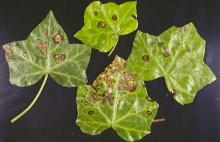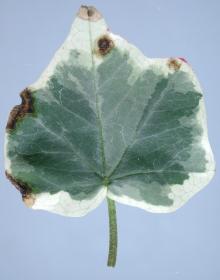Cause Xanthomonas hortorum pv. hederae (formerly Xanthomonas hederae pv. hederae), a bacterium spread by splashing water and thus favored by overhead irrigation. Dense foliage and closely spaced plants favors disease spread. Bacteria may enter the plant through either wounds or stomata and hydathodes. They survive in infected plant debris and in the soil.
Symptoms Leaf spots are at first light green and water soaked; later they turn brown or black with reddish margins. Spots may be circular or angular when near large veins. Older leaves are often the first to develop symptoms. Older lesions become cracked, often in their centers.
Leaf stalks also become black and shriveled. A black decay extends from the twig tip down into the old wood, and cankers girdle the stem. Under warm moist conditions, a bacterial ooze may be on stems.
Cultural control
- Pick off affected leaves when first infections occur. Remove and destroy heavily infected plants.
- Avoid overhead irrigation. Water plants from below, if possible by drip irrigation.
- Maintain high nutrition.
- The cultivars California, Eva, Gold Dust, Manda Crested, Perfection, and Sweet Heart may have useful resistance to this disease.
Chemical control Combine with cultural control methods because chemical control is difficult and often ineffective.
- Agri-Mycin 50 at 5.3 to 16 oz/100 to 300 gal water/A. Tolerant strains of the bacterium easily develop with repeated use of this product. Alternate with other bactericides to prevent or delay buildup of tolerant strains. Group 25 fungicide. 12-hr reentry.
- 12-hr reentry.
- Badge X2 at 1.5 to 2 lb/A. Group M1 fungicides. 24-hr reentry.
- CuPRO 5000 at 1.5 to 5 lb/A. May discolor foliage. Group M1 fungicide. 48-hr reentry.
- FireWall 50 WP at 1.36 oz/25 gal water. Group 25 fungicide. 12-hr reentry.
- Grotto at 0.5 to 2 gal/30 to 100 gal water/A. Group M1 fungicide. 4-hr reentry.
- Kalmor at 1 lb/100 gal water. Group M1 fungicide. 24-hr reentry. O
- Monterey Liqui-Cop at 3 Tbsp/gal water. H
- Nu-Cop 50 DF at 1 lb/100 gal. Foliage discoloration has been noted. Group M1 fungicide. 48-hr reentry.
- Phyton 27 at 1.5 to 5 oz/10 gal water. Group M1 fungicide. 48-hr reentry.
- Although Aliette and Areca are registered, they are not recommended because control is too variable and the material is not compatible with copper products.
Biological control
- AmyloShield (Bacillus amyloliquefaciens strain PTA-4838) at 1.5 to 3.5 lb/A outdoor or 0.6 to 1.2 oz/gal in the greenhouse. Group BM02 fungicide. 12-hr reentry. O
- Triathlon BA (Bacillus amyloliquefaciens strain D747) at 0.5 to 6 quarts/100 gal water. Group BM02 fungicide. 4-hr reentry. O
References Chase, A.R. 1993. Efficacy of fosetyl-Al for control of some bacterial diseases on ornamentals. Plant Disease 77:771-776.
Suzuki, A., Kusumoto, S., Horie, H., and Takikawa, Y. 2002. Bacterial leaf spot of ivy caused by Xanthomonas campestris pv. hederae. Journal of General Plant Pathology 68:398-400.



